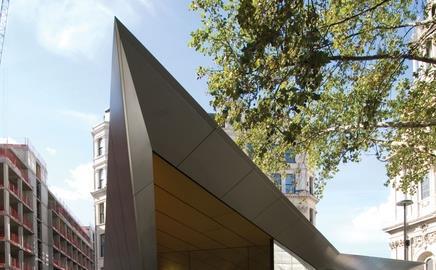Make’s City of London information centre had to look as distinct from nearby St Paul’s cathedral as possible, which led the architect to search for a cladding supplier with a flair for origami
The City of London information centre is due to open later this month. The £1.6m building, designed by Make Architects and influenced by origami will showcase the financial district’s eclectic, contemporary and historic attractions. The site sits in the shadow of St Paul’s cathedral but has been deliberately designed to contrast with its surroundings.
When it came to sheathing the building in its stainless steel skin, they turned to cladding supplier and installer Seele.
Sean Affleck, project architect with Make, and Thomas Spitzer, UK sales manager with Seele, explain how they turned the vision into reality.
What was your original vision?
Sean Affleck We wanted to create something totally different from St Paul’s cathedral as the information centre would be right next to it. It had to be sculpturally bold, so we played with the idea of origami and folded paper. For the cladding we wanted something durable that needed minimum maintenance, so stainless steel came to mind.
What did you think of the design?
Thomas Spitzer I thought it was very challenging, a complex design and a lot smaller than we would normally undertake, but it was unique and in a prominent location so we thought it would be exciting.
How was the design developed?
SA Once we had come up with the concept and run it past the client, St Paul’s, English Heritage and the planners, we got Seele and Skanska, the main contractor, on board and sat down to devise a solution. As all three companies were involved, we didn’t end up coming up with a design and taking it into the market place, only to find it couldn’t be built – we knew straightaway if it was possible or not.
TS It was a relatively long process.
Several construction solutions were looked at, including a monocoque system, but it was finally whittled down to a steel frame structure, clad in stainless steel. This was driven by what materials would be available to meet the requirements, and architectural intent – Make wanted very crisp lines.
What was the impact of Building Regulations?
SA We wanted to exceed Part L requirements, and we have done this by about 25%. The building has a breathable skin that helps prevent the transfer of heat from the external surface into the structure.
Were there any issues with the panels?
SA The manufacture dictated how the building looked, including the width of the panels and the angle they could be bent.
TS The biggest factor was how to utilise the standard rolls of stainless steel to generate minimum waste, while achieving crisp folds. We had to carefully organise the cutting to minimise offcuts. This is why we went for the omni-directional dimple surface pattern.
Were there any issues with buildability?
SA There was limited access, as St Paul’s is one of the most popular attractions in London, so we had to minimise our time on site. The other issue was the way the panels were fixed to the frame – the tolerances had to be carefully understood. We allowed up to 30mm of play with the fixings.
TS The length of the stainless steel sheets are longer than we have used on other projects. Because of site restrictions and the folds, these were made off site.
What do you think of it now?
SA I’m absolutely delighted. We left little to chance, but seeing the crispness of the joints and the way the surfaces pick up and reflect light exceeds all expectations.
Topics
Specifier 02 November 2007
- 1
- 2
- 3
- 4
- 5
- 6
- 7
- 8
- 9
 Currently reading
Currently readingHere’s one we made earlier
- 10
- 11
- 12
- 13
- 14


































No comments yet